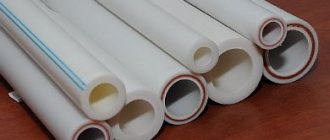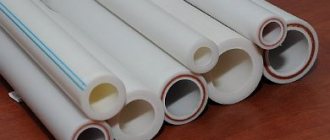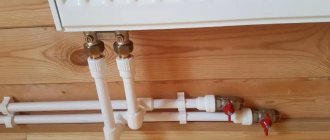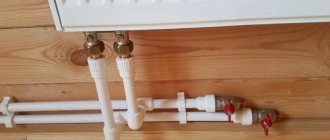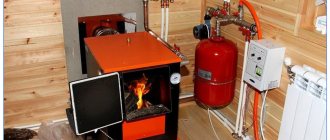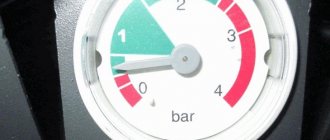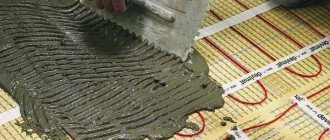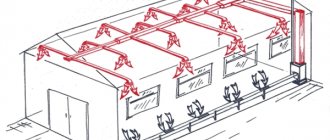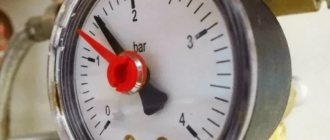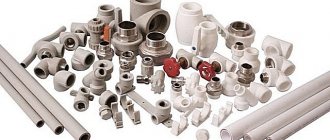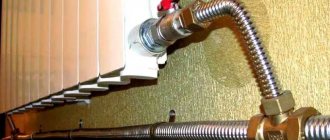For a long time now, polypropylene pipes have been replacing the usual metal ones from everyday life. This is due to their good performance characteristics, which were improved with the help of advanced technologies, including reinforcement. Today, polypropylene pipes are used in many areas of life. With their help, pipelines for heating and hot water systems are repaired and installed. Thanks to their high characteristics, plastic communications last a long time. It is durability, reliability and low cost that make them very popular on the market.
Below we will look at what pressure polypropylene heating pipes can withstand and what operating temperatures they are designed for. This will help you choose the most optimal systems for arranging heating and hot water supply.
Properties of polypropylene
This material is quite resistant to various impacts, as shown by the characteristics below. It is resistant to high temperatures (melts at 175°C), while it has good hardness, high resistance to bending, and low vapor and gas permeability. In addition, it has good wear resistance, which makes it quite durable. Thanks to its unique structure, this material is not afraid of chemicals. Therefore, it is not afraid of solvents (alcohols, ethers, ketones and even acids) contained in water heated to 60 degrees or more. He is also not afraid of the effects of salts and alkalis.
The disadvantage of polypropylene is sensitivity to light, which must be taken into account when using products made from this material in all areas. Under the influence of light and atmosphere, irreversible destructive processes occur in polypropylene, as a result of which it loses its shine, cracks and burns out. To prevent these unfavorable processes, special additives are added to the polypropylene composition.
Another disadvantage of this material is its low frost resistance (brittleness threshold from -5 to -15 ° C), but this can also be eliminated by adding ethylene units or ethylene-propylene rubber to the molecular lattice of polypropylene.
Aluminum reinforcement
There are solid and perforated reinforcement with aluminum foil.
Continuous reinforcement with aluminum foil is the most economical option for reinforced pipes.
In this case, a thin layer of aluminum is located between the layers of propylene, due to which the structure of the pipe is significantly strengthened. But these types of products, as well as others, are distinguished by a number of limitations in operation:
- the water temperature should not reach +60 °C, otherwise the pipe may become deformed and burst if overheated;
- all joints should be cleaned before soldering, which will significantly reduce the time spent on installing the system;
- the temperature at which aluminum-reinforced pipes freeze is only -5 °C. Therefore, when using this type of polypropylene pipe in a private house, it is strictly forbidden to turn off the heating;
- Experts do not recommend using these types of products to supply hot water, since due to constant temperature changes, the aluminum layer may collapse over time.
Aluminum perforation means a mesh with small holes. During the extrusion of polypropylene pipes, viscous material enters the perforations, thereby ensuring adhesion between the polymer and metal.
Thanks to aluminum reinforcement, the coefficient of thermal expansion is significantly reduced. However, some difficulties may arise during the installation of engineering systems. When socket welding, the aluminum shell and outer layer of polymer are first removed, and the pipe is cleaned to an amount that corresponds to the depth of its insertion into the fitting.
There are types of polypropylene pipes that do not require removal of the outer layer during installation. They, in turn, also have some disadvantages:
- Only the outer layer of the product, equal to half the wall thickness, is attached to the fitting;
- a nozzle for welding equipment is required;
- After you cut the pipe, it will need to be trimmed.
Glass fiber reinforcement
Types of pipes marked PPR-FB-PPR consist of two layers of polypropylene, between which fiberglass is located, which is why this product is called a “fiberglass” pipe.
A pipe reinforced with glass fiber compares favorably with a product with aluminum reinforcement:
- installation does not require calibration and cleaning;
- material and time costs are reduced due to the fact that the soldering procedure is similar to the connection of solid plastic pipes or other stripped polymer products;
- a pipe reinforced with fiberglass does not delaminate because it has a homogeneous structure;
- Glass fiber increases the rigidity of the pipes.
The disadvantage of a fiberglass pipe is that its thermal expansion is 6% higher than that of products with aluminum reinforcement.
Internal reinforcement with polypropylene
These types of products are essentially metal-plastic pipes, the outer layer of which is made of polypropylene. Such pipes are resistant to high temperatures.
The disadvantages of this type of polypropylene pipes are characterized by:
- multilayer - the presence of adhesive joints of two different materials;
- attaching only the outer layer of the product to the fitting;
- the possibility of contact of reinforcement with the transported medium.
Metal-polymer polypropylene pipes
Modern types of polypropylene pipes are distinguished by a classic five-layer metal-polymer construction, shown in the figure below:
This type of polypropylene pipes is used for water supply and heating systems.
Modern polypropylene products have a multilayer construction, just like metal-plastic products. The only difference is that for a classic metal-plastic pipe, PEX or PE-RT polyethylene is used as a polymer, and not polypropylene.
Below is a small table that will help you understand the technical characteristics of all types of polypropylene pipes and the features of their application:
| Types of reinforcement | Specifications | ||||
| Maximum temperature, °C | Minimum temperature, °C | Thermal expansion, deformation | Maximum pressure, atm | Scope of application | |
| Solid aluminum | 60 | 5 | Average | 1 | Cold water system |
| Perforated aluminum | 70 | 10 | Average | 1.5 | Open type heating |
| Fiberglass | 90 | 20 | Low | 2 | Hot water supply system, heating, heated floor |
| Composite | 95 | 20-30 | Absent | 2,5–3 | Any |
Reinforced polypropylene pipes
The main problem with the operation of polypropylene pipelines is their linear (lengthwise) expansion when used in heating and hot water supply. In these cases, the pipe can lengthen up to 10 cm per 1 m. Therefore, it is necessary to install compensators.
This problem is solved with the help of reinforcement (a special reinforcing layer of aluminum or fiberglass is added to the pipe wall). The essence of reinforcement is to increase the physical and mechanical properties of plastic.
This is what allows plastic pipes to compete with their metal counterparts in many respects. Products with fiberglass are marked - PPR-FB-PPR.
Multilayer (reinforced) pipe was developed specifically for high-pressure water supply systems.
Reinforced polypropylene pipe has the following advantages:
- resistant to chemical attack;
- does not emit substances hazardous to human health, therefore suitable for use in everyday life and the food industry;
- smooth inner surface, no sediment or scale deposits; dielectric;
- low noise and thermal conductivity;
- costs less than metal analogues;
- It weighs little, so it is easier to transport and install;
- the expansion coefficient is 5 times lower than that of products made from conventional polypropylene;
- withstands high temperatures and loads.
Main pipe diameters according to GOST
The diameter in the marking of PPR water pipes is indicated as the outer diameter. Moreover, the larger it is and the higher the PN, the thicker the pipe wall. Products of 16–20 mm are used for installing water pipes throughout the apartment and cottage. 25–32 mm is for the riser. Larger diameter options are intended for pipelines in multi-storey buildings, main networks and sewerage.
How to correctly calculate the diameter of a pipe based on its purpose
What pressure can polypropylene pipes withstand?
In the process of choosing the optimal material for plumbing and heating, the buyer has a question: what pressure is the polypropylene pipe designed for? To do this, you need to study their markings:
- PN 10 – designed for a nominal pressure of 1 MPa and a water temperature of 45°C (single-layer for cold water supply).
- PN 16 – designed for a nominal pressure of 1.6 MPa and a water temperature of 50°C (single-layer for cold water).
- PN 20 – designed for a nominal pressure of 2.0 MPa and a liquid temperature of 80°C (can be single-layer or multi-layer (reinforced), intended for heating and transporting hot water).
- PN 25 – designed for a nominal pressure of 2.5 MPa and a water temperature of 95°C (can be single-layer or multi-layer (reinforced), designed for heating systems and water supply for hot water).
If you are used to calculating pressure in atmospheres and you need to understand how many atmospheres a particular pipe can withstand, then 1 MPa = 9.87 atm.
In any case, despite the maximum permissible loads, it is not advisable to use even reinforced plastic pipes for a long time in the maximum permissible modes (maximum coolant temperature and maximum permissible pressure).
Polypropylene pipes, when heated strongly, lose their unique qualities and are destroyed under the influence of high pressure. Pipeline joints are also very susceptible to overheating and high pressure. If you want to maximize their service life, you need to constantly monitor their tightness.
In heating systems, water often circulates at a pressure of 1.6 MPa and higher, and hot water is mainly supplied to the hot water supply at a pressure of 0.2 - 2.0 MPa. When pipelines are operated at maximum permissible temperatures and pressures, their service life is significantly reduced. That is why you need to follow the manufacturers' recommendations.
Marking
In addition to the PN marking, which indicates temperature and pressure, all plastic pipes have:
- the word "pipe";
- abbreviated name of the material;
- SDR - the value of the ratio of the external size to the thickness of the walls;
- external profile size;
- operational class;
- working pressure limit;
- Standart room.
For example:
Pipe PP-R SDR 11-20´ 1.9 class 1/1.0 MPa GOST R 52134-2003, where:
- random polypropylene profile - SDR 11 copolymer;
- outer diameter 20 mm;
- wall thickness 1.9;
- class 1;
- permissible pressure 1 MPa.
According to their structure, profiles are divided into:
- S - single-layer;
- M - multilayer;
- TI - with a thermal insulation layer;
- PP - standard;
- PP-RP - high pressure resistant.
By type of material there are:
- PPB - they have high strength, their purpose is floor heating with hot coolant;
- PPH - have an increased internal diameter, mounted on ventilation systems and cold water;
- PPR is a universal type that can withstand elevated temperatures.
By class they are divided into:
- class 1 - up to +60 C, intended for water supply;
- 2 - up to +70 (pipelines);
- 3 - + 60 (warm floors);
- 4 - +70 C, used for heating;
- 5 - + 90 (heating);
- class XB - for cold water supply.
Some manufacturers put a trademark on their products.
Temperature table
For clarity, we have presented a table of temperatures that polypropylene pipes can withstand.
| View | Purpose | Maximum temperature level | Working pressure (atm) |
| PN 10 | Cold water supply | +40 C | 10,2 |
| PN 16 | Universal model | +60 | 16,3 |
| PN 20 | Universal | +80 — 95 | 20,4 |
| PN 25 | Hot water | +95 — 120 | 25,5 |
Features of use in a heating system
Destruction temperature of polypropylene pipes.
Today, polypropylene profiles are increasingly installed both in central heating systems and are used to heat private buildings. They do not deform, do not allow oxygen to pass through, are able to withstand sub-zero temperatures and, as a result, freezing of water in the main does not cause damage to the system as a whole.
To the question of which polypropylene pipe for heating is best to purchase, you can give a clear answer - you need to take a pipe that can withstand a maximum temperature of +60 - +95 C. The most suitable models are PN 20 with a heating degree of +60 or PN 25 - +95.
When choosing polypropylene profiles for heating, in addition to temperature, you should consider that:
- Plastic products are rigid and difficult to bend. To turn the highway, you need to install an angle, which is not very convenient.
- The cross-section of the pipes must correspond to the size of the risers to which they will be connected. In a private house, the central wiring is made from a profile with a cross-section of 32 mm, the connection to the batteries is made with pipes measuring 20 - 25 mm.
- PP pipe fittings have a large cross-section, which worsens the appearance of the system.
- Polypropylene stretches when heated, this leads to thinning of the walls and sagging of the pipeline, which looks unsightly when installed openly.
When installing a plastic pipeline, it is important not to overheat it, as this will lead to a decrease in the passage when inserting it into the fitting. This error significantly reduces the efficiency of the system.
In addition, polypropylene products are not recommended for piping boilers. In the boiler room there is a frequent change in temperature, which is contraindicated for this profile.
If you take into account all the above points, then polypropylene types with a maximum temperature of +95 are quite suitable for heating.
What temperature can polypropylene pipes withstand?
Polypropylene is a polymer, so it cannot withstand high heat. When heated to 140°C, it softens and can become deformed. When heated to 175°C, the material completely melts.
What temperature can a polypropylene pipe withstand? The maximum water temperature that can be transported is 95°C. Of course, it can withstand higher temperatures, but only for a short time. In other words, if you use a polypropylene pipe for a long time to transport coolant heated to 100°C or more, its service life is reduced significantly.
Heating systems mainly circulate water at a temperature of 90°C. DHW systems supply hot water heated to 65°C. Polypropylene, like many materials, changes in size with temperature changes. In other words, when heated it expands, and when cooled, on the contrary, it contracts. At maximum water temperatures, the plastic bends, sags and swells.
General information
The category of thermoplastic pipes includes all types of plastic pipes. These are polypropylene, polyethylene (including cross-linked), polyvinyl chloride and polybutene. All products are manufactured in accordance with GOST. Its number is 521343-2003. The technical characteristics of the materials are also indicated here.
Types of material
In the above legislative document, polypropylene pipes are presented in three positions with different technical characteristics:
- Polypropylene homopolymer marked PP-H or PP of the first type, PP-G.
- Polypropylene block copolymer – PP-B. Russian marking is PP of the second type or PP-B.
- Polypropylene random copolymer – PP-R. The Russian marking is PP of the third type or PP-R.
The latter material is considered a breakthrough in the creation of pipelines for various purposes. Therefore, PP-R is used more often than others in the production of polypropylene pipes.
All polypropylene structures with a diameter of up to 180 mm are produced in coils. Above this size - in straight sections.
Special properties of polypropylene pipes
Advantages of this material:
- increased strength, the ability to withstand high pressure of the medium that moves along the highway;
- polypropylene is environmentally friendly - when heated and at high humidity it does not emit toxic substances;
- has a low thermal conductivity coefficient, which is important when it comes to propylene pipes for hot water;
- service life – at least 50 years;
- low specific gravity, which simplifies unloading and loading, transportation, moving, storing and connecting sections to each other.
Scope of pipe rolling
The list of applications where polypropylene pipes are used is wide. This includes almost all types of human activity, including the domestic sector, industry and agriculture. Eg;
- water supply: cold and hot;
- heating system, including heated floors;
- ventilation;
- drainage;
- irrigation systems;
- pipelines with aggressive media;
- pipelines pumping air under pressure.
Rated temperature and area of application
The technical characteristics of polypropylene pipes include a reliability indicator that depends on the temperature of the medium flowing inside the pipeline. According to this characteristic, pipes are divided into five classes. And all the above-mentioned types, and these are PP-H, PP-R, PP-B, are included in them.
They can withstand temperatures up to +80°C, depending on whether they belong to a particular class.
Reliability Specification
This technical characteristic is indicated in the marking of a polypropylene pipe - the class of the product is written on the wall. It will be written - class 5, as shown in the picture below.
Marking indicating class
According to GOST, the service life of a polypropylene pipeline is determined by the total operating time at high temperatures. Where the maximum value is 50 years.
Some manufacturers are trying to use the latest technologies that allow them to produce material with higher temperature parameters. There are no restrictions in this regard. But the marking will still indicate “class 5” as the maximum technical characteristic according to GOST.
All polypropylene pipes from the classification can be used on pipelines with cold water, the pressure of which should not exceed 1 MPa.
Who to trust with pipeline installation
The performance of the entire pipeline depends on the quality of installation, so installation work should be carried out by professionals. They will design and calculate everything correctly, while taking into account the temperature conditions of the future pipeline. Only experienced specialists know what pressure polypropylene pipes are designed for, and what pipe diameter is most suitable in a particular case. It is worth noting that the companies provide a guarantee for all work performed. If something breaks or leaks, you will receive help quickly and free of charge. This is especially true in winter.
Plastic pipes ⌀ 20 mm are most in demand among professionals today. When choosing independently, users do not know what pressure a 20 mm polypropylene pipe can withstand. Such products are capable of working with a liquid pressure of 2.0 MPa. This is quite enough for arranging heating and hot water supply.
Polypropylene pipes have many advantages. However, they also have disadvantages that must be taken into account when selecting materials for pipelines. If you follow all operating instructions, polypropylene water supply will serve you flawlessly for many decades. The most important thing is to install plastic pipes and components only from well-known, trusted manufacturers. If a plastic pipeline is combined with a metal one, it is advisable to install cleaning filters. This will protect the system from various impurities.
A little history
At the end of the Soviet era, despite the global shortage, microdistricts of houses were built in the regions of the Far East according to a standard design, popularly called Leningradsky.
During the construction of these houses, an attempt was made to reduce the cost of construction. The walls of the houses were made of panels, but the windows were triple glazed. The heating devices are convectors of a strange design, a curved pipe with an internal diameter of no more than 20 mm with thin steel plates tightly strung on it.
The Far Eastern climate is harsh, with winter temperatures dropping below -30⁰C. When there is a strong wind, the heat loss of a panel house becomes simply enormous and tiny convectors, designed for completely different operating conditions, simply cannot cope with the task. In order to somehow compensate for heat loss, it was necessary to increase the temperature of the coolant beyond 100⁰С, fortunately the parameters of the heating mains allowed this.
Unfortunately, many residential buildings do not have an automated water supply control system. And the prospects for its appearance are vague. When the outside temperature drops to 35⁰C, the thermal power plant, to maintain the temperature regime, raises the coolant readings to 130⁰C. Thanks to pressure, water continues to flow through the pipes, not steam (about
Video description
How to solder polypropylene pipes
But in situations where reliability is required, steel clamps with a plastic dowel are used for fastening. There are rubber gaskets on the inside of both halves of the clamp. Clamps of this design secure not only polypropylene, but also polyvinyl chloride and metal pipes.
For the most part, PPR pipes are hidden under plaster, drywall or PVC/MDF panels, but for this they also need to be fixed somehow. Usually, a channel is cut for a water supply, and the pipe itself is secured with a perforated strip suspension to prevent it from falling out. This can also be done without a groove - simply press the PPR tape, like a clamp, pulling it on both sides with plastic dowels with self-tapping screws.
Characteristics of PPR pipes and scope
Each PPR product is marked with encrypted data on the diameter and wall thickness, operating pressure, service class, pipe material and much more.
There are several modifications of polypropylene, each of which has its own operating characteristics:
- PPH – products made from homopolymer, used exclusively in cold water supply.
- PPV pipes are made of block copolymer, the scope of application is cold water supply and installation of heated floors.
- PPR is the most common material - a random copolymer of polypropylene, used in the installation of heated floors, for hot water supply and water heating.
- PPs – polypropylene with improved heat-resistant properties, rarely used in domestic water supply systems.
For cold water supply and drinking water supply, it is enough to use PN10 pipes made of homopolymer, since the low temperature environment practically does not cause linear expansion, and the pressure in the household pipeline is below 1 MPa.
In heating systems and for supplying hot water, it is advisable to install reinforced pipes with fiberglass or aluminum foil (basalt fiber has only recently appeared on the pipe market and has not yet gained much popularity).
Reinforcement in a hot water pipeline is necessary as it restrains the linear expansion of polypropylene and prevents deformation of the pipes. Products with an aluminum layer can be used in any conditions, since the metal foil provides additional rigidity without practically increasing the outer diameter. Fiberglass is best used indoors.
Important! If the pipeline section will pass through open air, it must be protected from ultraviolet rays. The ideal solution would be to use a polyurethane foam shell.
Video description
Soldering polypropylene pipes: technology, tools.
In 90% of cases, when installing polypropylene circuits, there is a need to switch from a metal pipe to PPR. Most often, for such purposes, electric welding is used to weld a fitting for screwing on a PPR fitting. When you yourself are not a welder, but there is no one to ask, then a whole problem can arise from this, but there is still a way out. These are threadless compression couplings, as in the photo above, or the same tees for tapping. That is, instead of welding a fitting, the pipe is cut and a tee is fixed on it, or a coupling with one nut is screwed onto its edge. For the household level, this is just a godsend.
Pipes can be bypassed using an insert Source sovet-ingenera.com
Sometimes it becomes necessary to intersect one or more pipes across their direction. This issue can be solved in two ways: solder the transition in the form of the letter “P”, using four 90° corners, or, as in the top photo, use a piece of pipe, which is called a bypass. That is, this is not even a fitting and you will need two through PPR couplings. The radius of this device can be larger or smaller - it all depends on how many rows you have to go around. In rare cases, in a store you can find a bypass for one row and it has inlet holes for welding on both sides.
Such fittings are used for connection to electric boilers Source izi.ua
